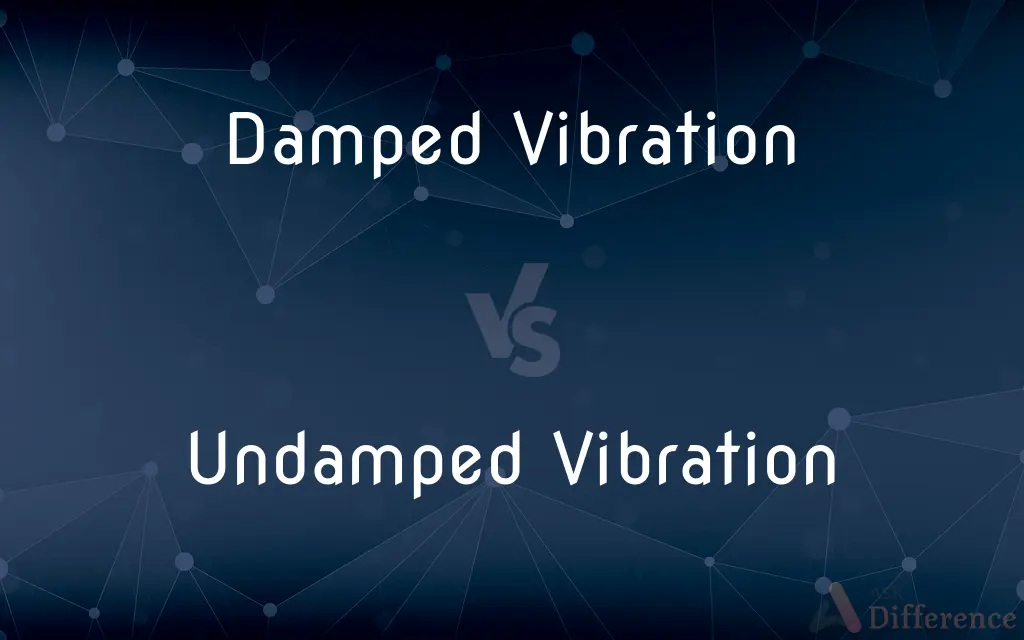Damped Vibration vs. Undamped Vibration — What's the Difference?
By Tayyaba Rehman — Published on January 2, 2024
Damped Vibration involves gradual energy loss, reducing amplitude over time. Undamped Vibration maintains constant amplitude, with no energy loss.

Difference Between Damped Vibration and Undamped Vibration
Table of Contents
ADVERTISEMENT
Key Differences
Characterized by decreasing amplitude due to energy dissipation. Undamped Vibration: Exhibits constant amplitude as there's no energy loss.
Involves external forces like friction or air resistance reducing motion. Undamped Vibration: Idealized form assuming no external forces are acting.
Real-world applications, like shock absorbers, use damping to reduce oscillations. Undamped Vibration: More theoretical, used in models where damping is ignored for simplicity.
Can be over, under, or critically damped, affecting the system's response. Undamped Vibration: Represents a system's natural frequency without external interference.
The system eventually comes to rest due to energy dissipation. Undamped Vibration: Without damping forces, the system would theoretically oscillate indefinitely.
ADVERTISEMENT
Comparison Chart
Amplitude Change
Decreases over time
Remains constant
Energy Loss
Energy is dissipated, usually as heat
No energy loss occurs
External Forces
Affected by forces like friction
Assumes no external forces
Realism
Common in real-world systems
Mostly theoretical or idealized
System's Rest State
Eventually comes to rest
Would oscillate indefinitely
Compare with Definitions
Damped Vibration
Vibration with decreasing energy, leading to eventual rest.
The building’s damped vibration after the quake prevented structural failure.
Undamped Vibration
A theoretical form of motion, idealized without damping.
Undamped vibration is often used in simulations for simplicity.
Damped Vibration
Vibration that decreases in amplitude over time due to energy loss.
The damped vibration of the car's suspension provided a smooth ride.
Undamped Vibration
Continuous oscillation that, in an ideal scenario, would persist indefinitely.
The concept of perpetual motion is akin to undamped vibration.
Damped Vibration
Oscillation where external forces cause gradual motion reduction.
In the experiment, the damped vibration of the pendulum was evident.
Undamped Vibration
Vibration maintaining constant amplitude without energy loss.
In theory, the undamped vibration of a perfect pendulum would last forever.
Damped Vibration
A real-world oscillatory motion affected by resistive forces.
The bridge's damped vibration during high winds ensured stability.
Undamped Vibration
Oscillation without the influence of external resistive forces.
The model assumed undamped vibration, ignoring air resistance.
Damped Vibration
A motion characterized by energy dissipation, often as heat.
The damped vibration in the mechanical system prevented damage.
Undamped Vibration
Vibration representing a system's natural frequency, unaltered by damping.
The machine was tested for its natural frequency through undamped vibration.
Common Curiosities
Is Undamped Vibration common in real systems?
No, it’s mostly a theoretical concept, assuming no external damping forces.
What causes Damped Vibration?
External forces like friction or air resistance causing energy dissipation.
Can Damped Vibration be fully stopped?
Yes, it eventually comes to rest due to continuous energy loss.
Are there types of Damped Vibration?
Yes, including over-damped, under-damped, and critically damped.
Would Undamped Vibration ever stop naturally?
In theory, without external forces, it would oscillate indefinitely.
Is Undamped Vibration practical in engineering?
Rarely, it’s mostly used in simplified models or theoretical studies.
What real-world application uses Damped Vibration?
Shock absorbers in vehicles are a common application.
Define Undamped Vibration.
It’s an idealized vibration maintaining constant amplitude without energy dissipation.
What is Damped Vibration?
It’s vibration where amplitude decreases over time due to energy loss.
Does Undamped Vibration have any practical use?
It’s useful for understanding a system's natural behavior without external influences.
Can Undamped Vibration exist in nature?
Practically no, as natural systems always experience some form of damping.
How does Damped Vibration affect system stability?
It often increases stability by reducing oscillations.
What energy forms are involved in Damped Vibration?
Energy is often lost as heat due to friction or other resistive forces.
Can Undamped Vibration be achieved in a vacuum?
Even in a vacuum, internal damping factors can prevent true undamped vibration.
Are both Damped and Undamped Vibrations important in physics?
Yes, understanding both helps in studying and designing oscillatory systems.
Share Your Discovery

Previous Comparison
Platinum vs. White Gold
Next Comparison
HashMap vs. ConcurrentHashMapAuthor Spotlight
Written by
Tayyaba RehmanTayyaba Rehman is a distinguished writer, currently serving as a primary contributor to askdifference.com. As a researcher in semantics and etymology, Tayyaba's passion for the complexity of languages and their distinctions has found a perfect home on the platform. Tayyaba delves into the intricacies of language, distinguishing between commonly confused words and phrases, thereby providing clarity for readers worldwide.












































